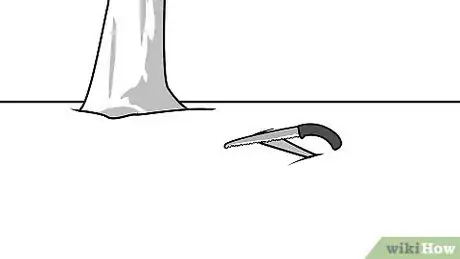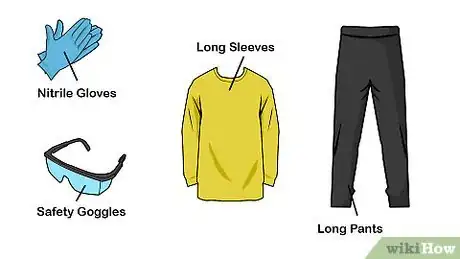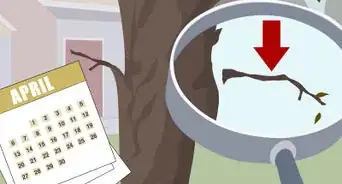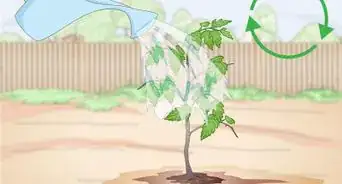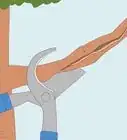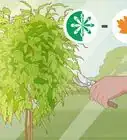This article was co-authored by Andrew Carberry, MPH. Andrew Carberry is a Food Systems Expert and the Senior Program Associate at the Wallace Centere at Winrock International in Little Rock, Arkansas. He has worked in food systems since 2008 and has experience working on farm-to-school projects, food safety programs, and working with local and state coalitions in Arkansas. He is a graduate of the College of William and Mary and holds a Masters degree in public health and nutrition from the University of Tennessee.
There are 25 references cited in this article, which can be found at the bottom of the page.
wikiHow marks an article as reader-approved once it receives enough positive feedback. In this case, 82% of readers who voted found the article helpful, earning it our reader-approved status.
This article has been viewed 792,476 times.
You don’t often think about the web of roots underneath the tree in your yard until they start wreaking havoc. A cracked foundation or busted up driveway is no fun, and no matter how much you love a tree, sometimes the roots have got to go. The good news is that you have multiple options for killing tree roots (or even the entire tree depending on how serious it is) yourself.
Please note: The WHO considers glyphosate to be a probable human carcinogen. Its use is prohibited in some states and countries. Please check with your local laws and use caution if handling this chemical.
Steps
Killing Invasive Roots in the Ground
-
1Cut small problem roots. Although labor-intensive, this directly addresses the issue with no risk to nearby plants. Dig out the soil around and under the root first, then cut with a root saw or loppers.[1] Cutting roots aggressively can put the tree in a long decline, potentially killing it over many years.[2] Follow these rules of thumb to prevent this:
- Multiply the diameter of the tree by eight. That's the minimum distance from the trunk you can cut with low risk of serious harm.[3]
- Cut roots on one side of the tree only, especially if you're risking a cut closer than the minimum distance.
-
2Dig a trench to block roots. Cutting roots once is only a temporary solution. To maintain the area, you may need to dig a trench and cut away the roots annually — or up to twice a year for aggressive root systems.[4] You can save yourself from this chore if you dig one deep trench (ideally through the entire topsoil), then install one of these barriers before backfilling:
- Galvanized metal roofing. Fold the top over to avoid a dangerous sharp edge.[5]
- A double layer of HDPE plastic,Overlap sections of barrier by at least 12" (30 cm) so roots can't slip through.sometimes available free from feed stores[6]
- For best results, buy a commercial root barrier treated with herbicide. Trifluralin is a common option unlikely to harm nearby plants.[7]
Advertisement -
3Kill suckers with herbicide. Some trees respond to cut roots or other damage by sending up new suckers from the root system. To kill these selectively, sever the root so the herbicide does not travel to the main tree. Apply an herbicide that contains glyphosate or triclopyr amine carefully to the sucker so it does not spray to nearby plants.[8] Many suckering plants grow aggressively. If you are not willing to kill the main tree, you will need to repeat this treatment or periodically dig up the suckers by hand.
- If you've cut down the main tree but suckers are still appearing in your yard, your only option may be to apply a broadleaf herbicide. This will kill all vegetation in the area. Repeat each time suckers appear until the roots run out of nutrients.[9]
-
4Replace damaged pavement with crushed stone or mulch. It may not be possible to kill large surface roots without killing the whole tree. If that's not an option, you can install a surface the tree cannot break through. Since this does not kill the roots, it will not protect garden areas or sewage pipes.
- Carefully remove any damaged concrete with minimal damage to roots.
- Cover the area with geotextile fabric. Leave 6" (15 cm) of clear ground around the trunk, or 12" (30 cm) for large trees.[10]
- Cover with 3–4" (7.5–10 cm) of crusher run (a type of crushed stone aggregate) or 6–8" (15–20 cm) of coarse mulch. Mulch is less effective, and may wash away in rain.
- Edge the material with stones to minimize shifting.
Dealing With Roots in Sewer Pipes
-
1Pour copper sulfate or rock salt down your toilet. This is the easiest treatment, but it risks killing the whole tree or surrounding plants. Flush either product down your toilet bowl (never into a sink or shower) in ½ lb (¼ kg) increments or less, until you've added 2 lb (0.9 kg). Avoid running water into the pipe for 8–12 hours so the salt has time to kill the roots.[11] Follow all safety information on the label.Both chemicals can cause major damage to aquatic life. Their use may be regulated by your state or country, especially near water treatment plants.[12]
-
2Treat your pipes with a foaming herbicide. Foaming herbicides expand to fill the pipe and take some time to break down, making them the best option for sewage line root removal. Contact herbicides kill the roots quickly, while systemic herbicides can take a couple weeks but may kill the whole tree. Different foam consistencies are appropriate for different sizes of pipe, so read the label before buying.
- Some herbicides are toxic to fish or other wildlife. The label should describe the environmental impact, and may include information on how to minimize it.
- For best results, hire a professional plumber to apply metam-sodium. This is a corrosive chemical that requires training and safety equipment to use.
-
3Have a professional clear clogged pipes mechanically. If roots have clogged a pipe completely, they will block the flow of chemical treatments. Hire a plumber instead to clear the pipe with a Roto Rooter or similar mechanical tool. This also has the advantage of avoiding environmental impacts from herbicide.
-
4Repair the pipe. Unless you're willing to repeat this treatment regularly, the cleared pipe will need structural repairs to prevent root regrowth. Installing a lining inside your pipe requires less digging and disruption, but a complete pipe replacement is often cheaper.
- You may also need to remove or relocate any large trees near the pipe, or the roots will keep growing into the sewer pipe.
Removing a Stump or Tree Physically
-
1Research your tree first. Some tree species can produce root suckers, growing whole new trunks some distance from the stump. Removing the trunk will not kill the roots, and can even trigger new growth. Avoid this method with these species (not a comprehensive list):
- Elms, cherries, plums, and lilac trees can regenerate from roots after the trunk is damaged.[13] Use herbicides instead.
- Aspens, poplars, sumac, and black locust form "clonal colonies" of many trunks during normal growth.[14] Their roots are very difficult to control even with herbicides.[15] A local agricultural extension can recommend an effective herbicide treatment for your species.
-
2Cut the tree to a stump. If the tree still needs to be cut down, cut it so about 3–4 feet (0.9–1.2 m) of the trunk is still left above ground. This ensures that you have enough wood to grab onto to pull the trunk out of the ground.Warning: Felling a tree is very dangerous. If you do not have experience and the proper tools, the tree may fall in an unexpected direction.[16] Hire a professional if you have not done this before.
-
3Excavate the stump. Dig around the stump using a shovel, mattock, digging bar, or backhoe. Cut through the largest roots with an axe or saw as you reveal them. Clear a radius of about 4 feet (1.2 m) around the tree, or as much as you need to detach the main roots.
- Before taking a chainsaw to a root, place a board underneath it. This protects the chainsaw from dirt and rocks.
- Once you've made some progress on the hole, spray the area with a hose or pressure washer to reveal more roots.[17]
-
4Attach the stump to a winch. Most stumps are much too secure to remove manually, especially when freshly cut. Secure the stump to a hand winch anchored to a strong tree instead, or chain to a truck.
-
5Winch slowly. Even a hand winch can send a stump flying with lethal force when it bursts out of the ground. Pull in short, slow bursts to avoid this risk. If you are in a truck, alternate forward and reverse movement. Ideally, the stump should pull loose from the ground gradually, and fall gently on its side.
-
6Grind a stump down if necessary. Some large stumps may not budge even with a winch. For these, you'll need to rent a stump grinder (or hire a professional). These are dangerous machines, so wear protective glasses and ask the rental agency to train you. Here's the basic process:[18]
- Clear away any rocks near the stump that could damage the grinding wheel.
- Position the wheel a few inches above the stump's front edge.
- Start spinning the wheel, then lower it slowly about 3 inches (7.5 cm) into the stump.
- Slowly move the wheel from side to side to cut away wood to a 4 inch (10 cm) depth. Repeat with the next section of stump until it is level.
- Repeat the process until the whole stump is ground at least 8–10 inches (20–25 cm) below the ground, or deeper if you want to plant a new tree.[19]
-
7Fill hole. Pull out any remaining tree roots and fill in the hole where the tree was with soil. Plant grass seed on the top, water it, and you’re set to have a tree-free area that blends in with the rest of your yard.[20] The tree's roots should stop growing and eventually decompose.
Applying Herbicide to the Stump
-
1Know the risks. Roots of the same species often grow together when they touch. This means that an herbicide applied to one beech tree might spread through the roots and end up killing more beech trees in the same area.[21] This is especially likely with species that can form "clonal colonies," including aspens and black locust.
-
2Select an herbicide. Herbicides that contain glyphosate or triclopyr amine are effective at killing trees and available at garden stores.[22] Your species may respond to one of these more than the other. For example, glyphosate may do a better job controlling Russian olive, while triclopyr is the better choice for locust, maple, oak, and willow.[23]
- Triclopyr amine should work at concentrations of 8.8%.[24] For glyphosate, try to find a concentration of about 40%, then dilute with an equal amount of water. If that isn't available, apply undiluted product with at least 20% concentration.[25]
- Herbicides containing 2,4-D, dicamba, or picloram are risky, as they may spread to nearby vegetation and kill it as well. This shouldn't happen with careful application of glyphosate or triclopyr.[26]
-
3Wear safety equipment. Follow the herbicide label instructions to prevent dangerous exposure to the chemicals. At minimum, wear long sleeves and pants, closed-toe shoes, latex or nitrile gloves, and safety goggles.[27] Choose clothes you don't mind ruining.
- You do not need to wear a mask, since you will not be spraying herbicide into the air.
-
4Apply herbicide to a stump. This treatment should prevent all or most of the roots from spreading and growing new suckers after a tree is cut down. It does require a fresh cut surface, but as long as the tree was cut less than a few weeks ago, you can create a new one:[28] [29]
- Cut the stump close to the ground. Keep it as level as possible, so herbicide doesn't run off into the ground. Clear away sawdust.
- Using an old paintbrush, apply herbicide just inside the bark ring. This is where the living tissue is that will carry the herbicide to the roots.
- Dispose of the paintbrush and empty herbicide containers at a hazardous waste center.[30]
Applying Herbicide to the Trunk
-
1Kill a tree with herbicide. This is an easy alternative to chopping down the tree, although it may not be safe if the dying tree could drop branches on a path or road. Also, this may not work in springtime on trees that produce a lot of sap, since that tends to push out the herbicide. If neither of these are issues, apply herbicide with the "hack and squirt" system:[31]
- Chop downward into the trunk at a 45º angle to make a wedge.
- Insert a spray bottle with a narrow nozzle directly into the wedge. Squeeze in a little herbicide, trying not to get any outside of the cut.
- Consult your herbicide label to find out how many cuts to make, and how much herbicide to place in each cut (usually 1 mL or less).
- Some extra-aggressive trees require girdling instead, with herbicide applied to the freshly exposed wood.[32]
-
2Remove the dead wood. After a few days or weeks, branches of the tree should start to deteriorate and fall apart. As chunks of dead wood fall off the tree, remove and dispose of them.
- Some trees or root systems may require multiple coats of herbicide to fully penetrate the wood. If the tree survives, check your herbicide label for multiple application instructions. Expose a fresh layer of wood with each application.
-
3Remove the stump. After the tree is dead, dig up the stump using a shovel or backhoe. Keep in mind that it could take years for the tree to decompose on its own, so you do not want to wait. Make sure to remove the stump completely to prevent the roots from growing.
Expert Q&A
-
QuestionHow do I kill baby oak trees and not harm the soil?
 Andrew Carberry, MPHAndrew Carberry is a Food Systems Expert and the Senior Program Associate at the Wallace Centere at Winrock International in Little Rock, Arkansas. He has worked in food systems since 2008 and has experience working on farm-to-school projects, food safety programs, and working with local and state coalitions in Arkansas. He is a graduate of the College of William and Mary and holds a Masters degree in public health and nutrition from the University of Tennessee.
Andrew Carberry, MPHAndrew Carberry is a Food Systems Expert and the Senior Program Associate at the Wallace Centere at Winrock International in Little Rock, Arkansas. He has worked in food systems since 2008 and has experience working on farm-to-school projects, food safety programs, and working with local and state coalitions in Arkansas. He is a graduate of the College of William and Mary and holds a Masters degree in public health and nutrition from the University of Tennessee.
Food Systems Expert For young trees, you can cut them down and dig out the root system. If the roots are too developed to dig out, you can cut down any new growth until it stops coming up.
For young trees, you can cut them down and dig out the root system. If the roots are too developed to dig out, you can cut down any new growth until it stops coming up. -
QuestionHow do I kill a black walnut tree root?
 Community AnswerAny of the standard methods described here should work. Black walnut roots are toxic to other plants, and can continue to damage many other plants for months or years after the tree is killed. Digging up every root is nearly impossible, so consider planting tolerant species, or growing affected species in containers.
Community AnswerAny of the standard methods described here should work. Black walnut roots are toxic to other plants, and can continue to damage many other plants for months or years after the tree is killed. Digging up every root is nearly impossible, so consider planting tolerant species, or growing affected species in containers. -
QuestionHow do I prevent small trees and their roots from growing into a chain link fence?
 Community AnswerIf the tree is close enough to grow against the fence, there is no way to keep them apart without permanently removing one or the other. Killing roots that close to the tree will likely cause the whole tree to die. If the tree is encroaching from another property, that property's owner is usually legally responsible for addressing the issue.
Community AnswerIf the tree is close enough to grow against the fence, there is no way to keep them apart without permanently removing one or the other. Killing roots that close to the tree will likely cause the whole tree to die. If the tree is encroaching from another property, that property's owner is usually legally responsible for addressing the issue.
Warnings
- Some gardeners recommend pouring salt into the ground to kill tree roots, but this will kill all vegetation in the area, and may contaminate groundwater.⧼thumbs_response⧽
- Removing large roots can cause a live tree to blow over in strong wind.⧼thumbs_response⧽
- Herbicides can cause damage to your skin and lungs, especially in concentrated form. Follow label first aid instructions if you spill it on yourself.⧼thumbs_response⧽
- Rain within six hours of applying herbicide may wash it away.[37]⧼thumbs_response⧽
References
- ↑ http://www.treeremoval.com/tree-cutting/tree-roots/
- ↑ http://hort.ufl.edu/woody/disturbing.shtml
- ↑ http://www.treeremoval.com/tree-cutting/tree-roots/
- ↑ http://aces.nmsu.edu/ces/yard/2005/100105.html
- ↑ http://learn.eartheasy.com/2014/07/how-to-block-tree-roots-from-entering-your-garden/
- ↑ http://learn.eartheasy.com/2014/07/how-to-block-tree-roots-from-entering-your-garden/
- ↑ http://aces.nmsu.edu/ces/yard/2005/100105.html
- ↑ https://www.rhs.org.uk/advice/profile?PID=260
- ↑ http://aces.nmsu.edu/ces/yard/2004/071704.html
- ↑ http://www.coldclimategardening.com/2011/11/14/mulch-can-kill-trees/
- ↑ http://www.superterry.com/kill-tree-roots-sewer-line/
- ↑ http://www.deercreekalliance.org/pollution
- ↑ https://www.rhs.org.uk/advice/profile?PID=260
- ↑ http://www.nativetreesociety.org/multi/index_multi.htm
- ↑ https://journals.uair.arizona.edu/index.php/rangelands/article/download/10762/10035
- ↑ http://www.treeremoval.com/tree-removal-safety-guide/
- ↑ http://www.treeremoval.com/stump-removal/
- ↑ http://www.popularmechanics.com/home/lawn-garden/how-to/a129/stump-grinder-tips/
- ↑ https://www.rhs.org.uk/advice/profile?pid=229
- ↑ http://www.umass.edu/urbantree/factsheets/26killastump.html
- ↑ http://arnoldia.arboretum.harvard.edu/pdf/articles/1989-49-4-tree-roots-facts-and-fallacies.pdf
- ↑ http://edis.ifas.ufl.edu/ag259
- ↑ http://extension.arizona.edu/sites/extension.arizona.edu/files/pubs/az1401.pdf
- ↑ http://edis.ifas.ufl.edu/ag259
- ↑ https://ssl.acesag.auburn.edu/pubs/docs/A/ANR-1465/ANR-1465-low-archive.pdf
- ↑ http://extension.arizona.edu/sites/extension.arizona.edu/files/pubs/az1401.pdf
- ↑ http://extension.arizona.edu/sites/extension.arizona.edu/files/pubs/az1401.pdf
- ↑ https://www.rhs.org.uk/advice/profile?pid=229
- ↑ http://edis.ifas.ufl.edu/ag259
- ↑ http://earth911.com/recycling-guide/how-to-recycle-pesticides-containers/
- ↑ http://edis.ifas.ufl.edu/ag245
- ↑ http://soundnativeplants.com/wp-content/uploads/Girdling.pdf
- ↑ http://www.fs.fed.us/t-d/pubs/pdfpubs/pdf99242809/pdf99242809pt01.pdf
- ↑ https://www.youtube.com/watch?v=UPzsC428V7o
- ↑ http://www.coldclimategardening.com/2011/11/14/mulch-can-kill-trees/
- ↑ https://www.rhs.org.uk/advice/profile?pid=229
- ↑ https://ssl.acesag.auburn.edu/pubs/docs/A/ANR-1465/ANR-1465-low-archive.pdf
About This Article
To kill tree roots, dig out the soil around the roots and use a root saw or loppers to cut the roots out. If you want to kill the entire tree, you can make a cut in the trunk and then spray herbicide inside of it. If the tree has already been chopped down, brush the herbicide onto the top of the stump using an old paintbrush. Then, when the stump and roots die, you can pull them out of the ground and fill in the hole. If you want to learn more, like how to kill tree roots that got inside a sewer pipe, keep reading the article!
